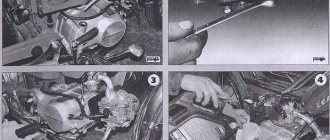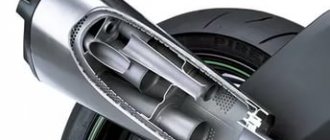Such engines are found on motorcycles (although recently four-stroke ones are used more often), chainsaws with a two-stroke engine, gas mowers, some voltage generators, etc. Owners of motorcycles, chainsaws, and gas mowers often wonder why the piston is jammed, or why the compression quickly disappears, that the engine does not start well, starts working intermittently, they remove the cylinder, the piston with large scuffs and crazy output.
I also once asked myself this question, it turned out that the whole issue is the oil with which gasoline is diluted.
There are a lot of special two-stroke oils on sale, I don’t even go near them now, this oil is not suitable for two-stroke engines developing high engine speeds.
Of course, if you have an IZH-Planet, it is a low-revving motorcycle, then you can pour two-stroke oil into gasoline, or be very gentle with your motorcycle, do not give it gas all the way, then two-stroke oil will work, but if you like to give it gas, this oil will quickly ruin the piston two-stroke group.
It seems that the developers of two-stroke oil simply invented it but did not even test it, and oils such as M8, MC20 should not be allowed close to a two-stroke engine if you like to drive, and if you do not give a lot of gas, then these oils can be used.
But they will still very quickly wear out the piston group of a motorcycle, chainsaws, gas mowers, in short, kill a two-stroke.
Why should you mix gasoline and oil?
Not everyone knows how to dilute gasoline for a two-stroke Chinese scooter, and why there is a need to mix gasoline and oil in strictly defined proportions. The fact is that the design features and operating principle of a two-stroke engine do not allow the use of pure gasoline for its operation. Thanks to the oil introduced into the fuel mixture, lubrication is provided and friction in the crank mechanism is reduced.
Mixing oil with gasoline when preparing the fuel mixture is a prerequisite for the normal operation of two-stroke engines.
Diluting gasoline with oil allows you to:
In addition, the use of gasoline mixed with oil in the required percentage allows you to avoid the occurrence of scuffing, which is the reason for repairs. A lack of oil can cause overheating of the elements of the cylinder-piston group and failure of the two-stroke engine.
An increased oil concentration will cause increased wear on the engine due to the formation of a thick layer of carbon deposits. That is why it is important to determine the proportion using the table, which indicates the required amount of oil for different volumes of gasoline.
How much oil to pour into gasoline - rules for preparing the mixture
Having figured out how much oil to pour into gasoline, you can start preparing the fuel mixture. To do this, you will need a clean metal or plastic canister. First, the required amount of gasoline is poured, and then lubricating fluid is added in the required volume. After completing the dilution, tilt the canister a couple of times.
As a result of repeated shaking, the liquids are mixed, and the prepared fuel acquires a uniform color. Depending on the color of the oil added, the finished liquid may be greenish, bluish or reddish.
When performing work, safety precautions and fire regulations must be observed. Mixing work must be carried out in a ventilated area, or even better, in outdoor conditions. Smoking is not allowed when working with flammable liquids. Mixing must be done with gloves to protect the skin from contact with aggressive liquids.
The fuel container is filled with the prepared mixture and the gas tank cap is tightly closed. Gasoline mixed with oil can be stored in tightly closed cans. Gasoline mixed with oil retains its properties for a month.
That is why mixing should be done immediately before pouring, taking into account the frequency of use of the scooter or motorcycle.
Table oil gasoline - choose the correct proportion
Beginning motorcycle owners do not always have an idea how much oil to add to gasoline. Depending on the manufacturer's recommendations specified in the instructions, the volume of added lubricant may vary. The most common ratios are 1:50 and also 1:40. Minor deviations from the specified proportions will not affect the operation of the two-stroke engine.
During the break-in period, when intensive grinding of the mating parts of the engine occurs, the amount of oil increases slightly. When the break-in is completed, switch to a different fuel mixture ratio, which involves introducing a smaller amount of oil.
It's not difficult to figure out the proportions. For example, a ratio of 1:50 means that a liter of lubricant should be added to 50 liters of gasoline. Using measuring containers will greatly facilitate the process of preparing the mixture. Depending on the volume of the available container, the amount of added oil changes.
In particular, for a proportion of 1:50, the table will help determine the volume of oil introduced:
Having decided on the proportions, you can quickly prepare the mixture. However, you should not use the gas tank for this, alternately filling in gasoline and oil. Mixing must be done in a separate container.
Why does a saw or motorcycle spit oil through the muffler?
Everything is fine here, I saw it like that and a motorcycle with a two-stroke engine spits out excess oil from the muffler. This means that you lightly pour oil into gasoline; if the engine is running perfectly, there is no need to worry. And if the engine floods the spark plugs, the engine starts to work intermittently, then reduce the amount of oil in gasoline by adding clean gasoline to the tank.
Gorobinsky S.V.
- Features and principle of operation of the 2t engine
- Why should you mix gasoline and oil?
- What oil to dilute gasoline for a motorcycle
- Table oil gasoline - choose the correct proportion
- How much oil to pour into gasoline - rules for preparing the mixture
- How to determine if mixing proportions are incorrect
Owners of scooters and motorcycles, as well as owners of gas-powered tools with a two-stroke engine, are faced with the need to pour a pre-prepared mixture of gasoline and oil into the fuel tank, maintaining the required proportions. Motorists know that they cannot refuel equipment with a two-stroke power unit with pure gasoline. This will negatively affect the operation of the motor, its service life and lead to inevitable breakdowns. The oil-gasoline table will help you determine the correct ratio of the amount of fuel and lubricant.
Let's take a closer look at the operating principle of a two-stroke engine, understand the mixing proportions, as well as the rules for preparing the fuel mixture.
How to determine if mixing proportions are incorrect
There are a number of indirect signs by which you can determine the discrepancy between the amounts of gasoline and oil when preparing the mixture:
Any of these signs indicates the need to adjust the mixing process. By observing the proportions recommended by the manufacturer, you can ensure a long service life of the two-stroke engine, as well as avoid unexpected and sometimes expensive repairs.
- Scooter Stels Skif 50
- Scooter Stels Skif 50
- Characteristics of the Yamaha Mint scooter
- Scooter Honda Lead AF 20
- Detailed review of the Nexus 150 scooter
- Characteristics of the Suzuki Address 110 scooter
- Motor scooter "Vyatka" - a miracle of domestic technology
- Scooter Tulitsa: technical characteristics
- How to properly install a piston on a scooter?
Jupiter 5 is one of the most successful creations of Soviet motorcycle production. Today, like 30 years ago, the device is often found on the streets of both remote outbacks and large cities, and, in most cases, the owner prefers to handle its maintenance independently.
The carburetor, being one of the most important components of any motor vehicle, is subject to intensive use and increased wear. Considering the great age of some models, replacing this module very often becomes an inevitable condition for extending the life of the unit.
The motorcycle is equipped with Izhevsk carburetors K-62D, K-65D, K-68D , or the Czechoslovak model Jikov-2928SE . There are few differences between the first two options: the design of the top cover; enrichment jet diameter; needle fastening (K-65D comes with a nozzle). The K-68D differs from its predecessor:
- Enlarged diffuser.
- A round (not square, like the K-65) damper.
- Lateral (more convenient for optimization) location of the idle screw.
- Threaded (for quick needle adjustment) top cover.
Which carburetor is better to install on IZ Jupiter 5? As you can see, the 68th model is more convenient to maintain , however, experienced motorcyclists note that it often contains defects, for example, in the form of the absence of a hole that improves the formation of the fuel mixture.
Jikov-2928CE is considered a higher quality carburetor, but also more difficult to operate and repair. Therefore, when choosing this option, you should prepare for possible difficulties, for example, when searching for replacement jets, because their size is much smaller than those from Izhevsk.
Rice. Carburetor K-62:
1 — idle fuel jet, 2 — main fuel jet; 3 — float chamber, 4 — sprayer; 5 — float axis, 6 — float lever bushing; 7 — air channel, 8 — nozzle, 9 — dosing needle, 10 — body; 11 — throttle, 12 — needle lock; 13 — throttle spring; 14 — throttle lift limiter (removed after engine break-in); 15 — throttle control cable, 16 — rod with idle speed adjustment screw (lowering the throttle); 17 - cover; 18 — idle speed adjusting screw, 19 — fuel inlet fitting, 20 — adapter hole, 21 — idle speed emulsion channel; 22 — drainage hole, 23 — idle air channel, 24 — locking needle with washer, 25 — float, 26 — corrector emulsion channel; 27 — dosing needle; 28 — float stopper, 29 — plunger, 30 — plunger spring, 31 — corrector control cable
Features and principle of operation of the 2t engine
Any owner of a motorcycle should have an understanding of the design of the engine and the principle of its operation. The two-stroke power unit is used not only in motorcycles, but also in other technical devices - gas mowers, trimmers and others. Despite the fact that many models of modern equipment are equipped with four-stroke engines, the two-stroke engine is still widely used. It is easy to operate, convenient to maintain and repair, and is also quite reliable.
The operating cycle of such an engine is carried out in a couple of compression and power strokes as a result of the energy from the ignition of the fuel. Both cycles are carried out during one revolution of the crankshaft. A two-stroke engine does not have the fuel mixture intake phase and the exhaust cycle, characteristic of four-stroke engines. The process of fuel intake and exhaust gas exhaust occurs during the compression and expansion phases.
Thanks to this design feature, the torque and power developed by the engine are increased at the same cubic capacity as a 4-stroke engine. And although the efficiency of a two-stroke power plant is lower compared to a four-stroke one, due to the two-stroke operation of the piston, the engine elements perform fewer movements. Provided that the mating parts of the motor are properly lubricated, it has a fairly long service life and is less susceptible to internal wear.
For a two-stroke to function, it is necessary to turn on the ignition, ensure the fuel supply and crank the engine crankshaft with a starter or kickstarter.
Further operation of the two-stroke engine is carried out according to the following algorithm:
In the process of supplying gasoline mixed with oil, the components of the power unit are lubricated. This distinguishes the lubrication system of a two-stroke engine from the lubrication system of a four-stroke engine, which has a gear pump to supply oil to the area of the mating parts of the engine.
What oil to dilute gasoline for a motorcycle
Two-stroke engines do not provide for separate filling of lubricant into the engine crankcase.
Strict requirements are imposed on the oil that burns together with the fuel:
The use of low-quality oil for two-stroke engines causes the formation of carbon deposits in the working chamber and a decrease in power.
When deciding on the type of oil, you should follow the recommendations of the equipment manufacturer specified in the operating manual. Preference should be given to branded oils produced by well-known manufacturers. The preferred oil class is API-TB. It is also possible to use oil marked API-TC.
The type of lubricant is selected depending on climatic conditions:
To obtain detailed information about the temperature threshold for use, you should read the information on the oil packaging. Knowing the ratio of fuel and oil required for stable engine operation, as well as the volume of the gas tank, you can easily calculate how much oil is required for a certain period, taking into account the frequency of trips or use of gas-powered tools.
When buying oil for preparing the fuel mixture, you should pay attention to its purpose. This information is indicated on the packaging. Do not use tractor oil or boat lubricant to mix with gasoline to fuel a scooter or motorcycle. Please note that on the branded label of oil for two-stroke engines it must be designated 2T.










